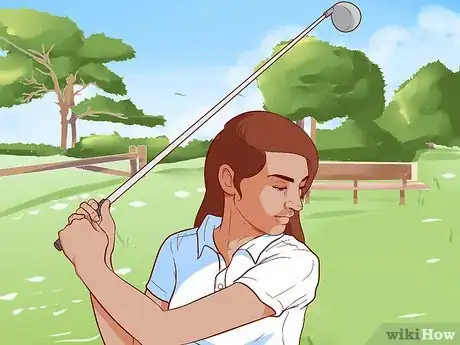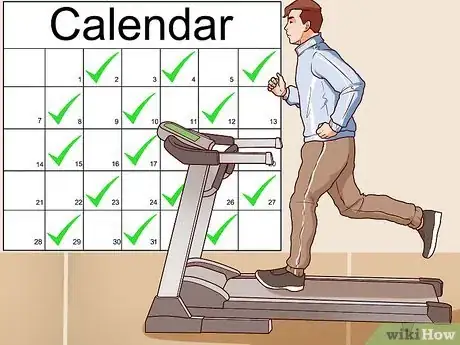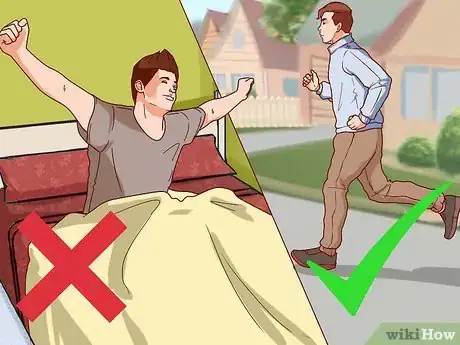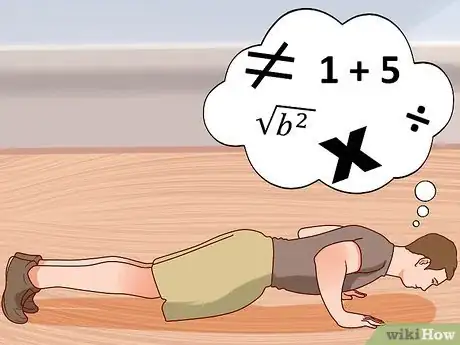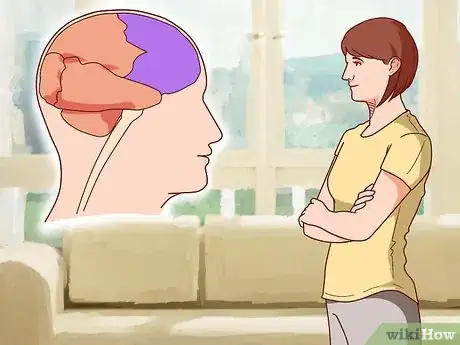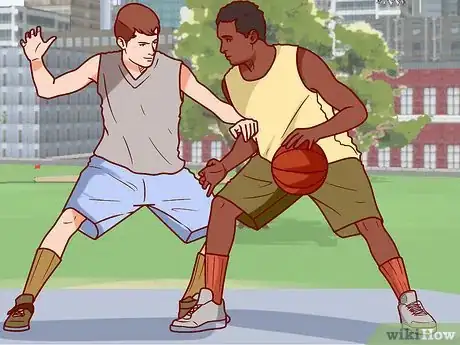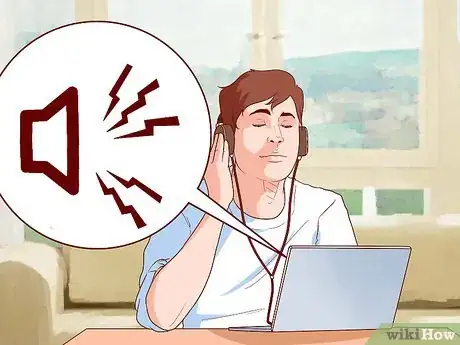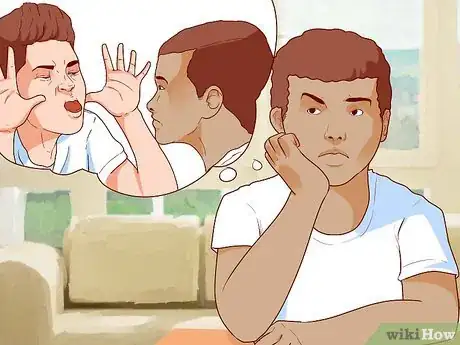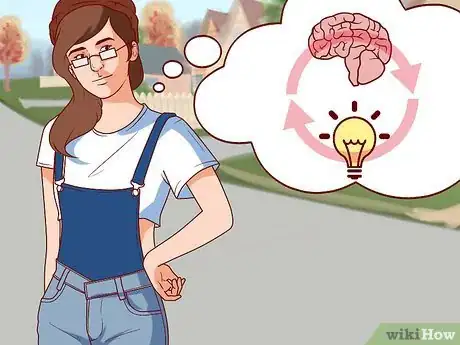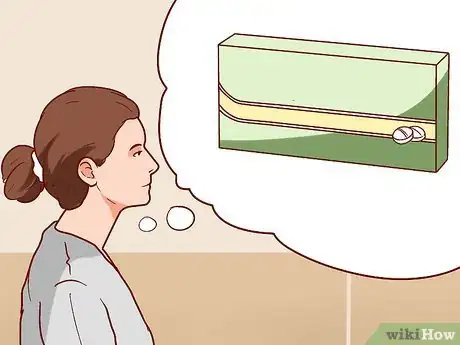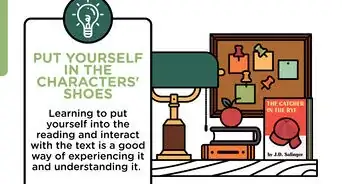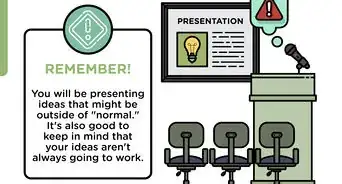This article was co-authored by Rahti Gorfien, PCC. Rahti Gorfien is a Life Coach and the Founder of Creative Calling Coaching, LLC. She specializes in working with artists, entrepreneurs, and college students in creative fields. Rahti is accredited as a Professional Certified Coach (PCC) by the International Coach Federation, an ACCG Accredited ADHD Coach by the ADD Coach Academy, and a Career Specialty Services Provider (CSS). In addition, she has personal experience in the fields she coaches - she is an alumnus of the New York University Graduate Acting program and has been a working theater artist for over 30 years. She was voted one of the 15 Best Life Coaches in New York City by Expertise in 2018.
There are 17 references cited in this article, which can be found at the bottom of the page.
wikiHow marks an article as reader-approved once it receives enough positive feedback. This article received 14 testimonials and 97% of readers who voted found it helpful, earning it our reader-approved status.
This article has been viewed 337,885 times.
Not so very long ago, scientists and doctors believed that the number of neurons, cells, and pathways that were present in our brains at birth were pretty much all there would be, so we should “use it or lose it”, as the saying goes. Your brain consists of four primary lobes, convoluted structures found within the lobes, left and right hemispheres, intricate communication networks, and more than 100 billion neural cells. The good news is, in recent years, the scientific research community has discovered a process called neuroplasticity. This means that the neuronal communication pathways and neural cells in the brain continue to grow throughout all the years of our lives. The process slows as we age, but it doesn’t stop completely as was once believed. Stimulating the growth of new neural cells and pathways to improve your thinking skills and your overall brain function can be done.
Steps
Exercising Your Brain
-
1Grow new neurons. Your brain is filled with literally billions of cells that contain a cell nucleus, axons, dendrites, and synapses.
- One proven way to grow new neurons is to learn. The existing axons, dendrites, and synapses, need to be maintained so don’t get lazy. Continue to perform the things you already do, including sports, reading, puzzles, exercise, crafts, or music.
- The key to growing new neurons is to teach yourself something different, maybe even something that feels awkward at first.
- Neuroplasticity of the brain, or the ability to grow new brain cells, happens if you take charge and expose your brain to something different.
-
2Try something new. Learn to juggle, dance, play a musical instrument, or anything that is new to you.[1]
- Even doing familiar things in a different way can help. For example, navigate your way through your home, safely, while walking backwards.
- Try anything you can think of that creates a challenge for your brain, but it must be something that requires you to think.
Advertisement -
3Perform neurobic exercises. Neurobics are exercises designed to stimulate new growth in the brain. The primary basis of neurobics involves using the senses to stimulate new brain pathways.Think of ways to challenge your brain by altering your sensory perceptions. Some basic examples follow:[2]
- Get dressed in the morning with your eyes shut or a blind-fold on.[3]
- Wear headphones that suppress sound while trying to verbally communicate with a friend. Include speaking and trying to understand what they are saying by mouth movements and hand gestures.[4]
- If you play the piano, try playing a simple and familiar piece with your eyes shut, or with two fingers taped together.[5]
- Try playing a simple piece using all fingers, but play the bass clef using your right hand and above middle C, and the treble clef with your left hand and below middle C.[6]
- Use your non-dominant hand for routine activities. Try brushing your teeth, combing your hair, and using a computer mouse using your non-dominant hand.[7]
- Write with your non-dominant hand.[8]
- Try writing several sentences from memory, perhaps the first verse of a familiar poem or song, making the letters upside down, as a mirror image, or from right to left on the page.[9]
- Try playing your favorite sport using your non-dominant hand.[10]
- Break your routines. Put your shoes on in the opposite order. Mow the yard in the opposite direction. Think of other frequent routines and alter their order.[11]
- Go for an early morning walk simply to identify smells around you.[12]
- Try to identify the ingredients in a meal just from taste and smell.[13]
-
4Improve whole brain blood flow. A recent study used only strategy-based brain training, without introducing any elements of physical exercise, to improve blood flow in the brain. The results showed that whole brain blood flow was significantly increased by using only brain-training exercises [14]
- The point of the study was to increase whole brain blood flow using only mental exercises.[15]
- When blood flow to the brain slows down, atrophy of brain tissues results. Atrophy in the brain means that cells degenerate, important communicate pathways degrade, and the brain tissue and important structures shrink away.[16]
- The study enrolled people of all ages that had suffered a traumatic brain injury, with about 65% of the enrollees having suffered the brain injury at least 10 years prior.[17]
- Part of the group was exposed to strategy-based brain training, and the others were exposed to general teaching materials, for the same amount of time, about how the brain works.[18]
- The group that received the strategy-based training improved abstract thinking scores by more than 20%, memory function measures improved by 30%, and the whole brain blood flow showed a significant increase as compared to the control group.[19]
- Many of the group participants also suffered from symptoms of depression and post-traumatic stress disorder. Depressive symptoms were improved in the strategy-based training group by 60% and post-traumatic stress disorder symptoms improved by almost 40%.[20]
- Strategy-based brain training really works to increase whole brain blood flow and can help to prevent brain shrinkage.[21]
-
5Try strategy-based brain training. This form of brain training is common and can be found all around you, including in your daily newspaper.[22]
- Strategy brain games are any games that you have to think about to solve. Do a crossword puzzle, a word-scramble puzzle, complete a Sudoku puzzle, or put together an actual table-top puzzle. Puzzle games that are not left to chance, that require you to think about them to solve them, are considered strategy-based brain games.[23]
- Play with another person. Games like chess, Go, or even checkers, involve thinking about your moves, and anticipating the moves of the person you are playing against.[24]
-
6
-
7
-
8
-
9Participate in making music. The musical experience is a valuable one. Do something musical that you are not accustomed to doing.[31]
- If you already play an instrument, learn to play a different one.[32]
- Join a singing group. Even if you cannot sing well, joining a choir or vocal group will significantly expand your brain function on several levels.[33]
- You will learn to understand organization of the music on the pages you will be singing, timing and rhythm, and organized singing. Plus, you will be exposed socially to a new group of people which provides a wonderful opportunity to expand your brain even further as you learn about music.[34]
-
10Take a class. Try a cooking class, auto mechanics, wood-working, sewing, or crafting.[35]
- Taking a class in something that you do not know how to do, but are interested in learning, helps to develop new pathways in your brain.
- This happens both by learning the new material and interacting with new people in a new environment.[36]
-
11
-
12Learn a new sport. Try a sport that is new to you, and consider one that involves at least one other player.[39]
- Golf is a sport that you can basically play alone, but it is more challenging when you play with someone. This creates additional experiences for your brain to organize and react to, and therefore the growth of new brain cells and pathways result.[40]
-
13
-
14Develop friendships with a diverse group. Having conversations on topics with people that have very different opinions challenges your brain, and your executive function abilities, to determine how you respond to the same topic but in different groups.[43]
- The more diverse your friends are, the more your brain is challenged to become creative both in conversation and in participation of different types of social interactions.[44]
Exercising Your Body to Improve Your Thinking Skills
-
1Participate in aerobic exercise. More and more research points to physical exercise as the most effective way to improve thinking skills and overall brain function.[45]
- Create an exercise routine that includes one hour sessions, three times a week, and basic exercises like walking on a treadmill or riding a stationary bike.[46]
- Stay with your exercise routine for at least 12 weeks in order to improve your brain fitness, cognitive abilities, and thinking skills.[47]
- A recent study done in sedentary people, aged 57 to 75 years of age, supports this level of exercise with scientific data.[48]
- The exercise group showed rapid improvement in circulating blood flow to areas of the brain, significant improvement in both immediate and delayed areas of memory function, improved cognitive abilities, frontal lobe functioning, visuospatial skills, processing speed, and overall improved cognition. Cardiovascular measures included as part of the study design were also notably improved.[49]
- The authors interpret the study results as further indication that any person, at any age, can take steps through the use of physical exercise to positively influences brain neuroplasticity.[50]
-
2Integrate exercise with your study habits. Recall of vocabulary words was significantly improved when exercise was included just before, during, or immediately after, exposure to the vocabulary words.
- Two different studies, one in female college students, and one in male college students, validated much improved recall of vocabulary words studied when associated with exercise.
- The female students did the best when they were exposed to their vocabulary words for 30 minutes while they were also exercising. The form of exercise in this study was riding a stationary bicycle for 30 minutes.[51]
- The male students were divided into groups that included no exercise, moderate exercise, or vigorous exercise. The improvement was noted in the students that were exposed to their vocabulary words either immediately prior, or immediately after, vigorous exercise.
-
3Exercise to increase your BDNF levels. Cognitive function and memory recall is improved when a substance called brain-derived neurotrophic factor, or BDNF, is elevated.[52]
-
4Start exercising now; the younger the better. Structures within our brain perform different functions and communicate through complex networks to keep our thinking skills sharp and memory function stable, help make critical decisions, strategize ways to solve problems, process and organize incoming information, keep our emotions in check, and control how we respond to countless situations.[55]
- When structures in the brain lose volume, or start to shrink, our brain function declines along with the parts of the brain that are shrinking. Exercise helps to prevent shrinkage.[56]
- The prefrontal cortex and hippocampus, structures in the brain that support memory function and higher-level cognitive functions, begin to shrink at a rate of about 1% to 2% each year for people over the age of 55 years.[57]
- Research done in 2010 showed the first documented evidence that exercising early in life helps to prevent shrinkage in the brain in later years, reducing the risk of cognitive decline.[58]
-
5Get up and move. The scientific community is still working to determine the best exercises to do, and how long to do them, in order to provide the greatest improvement in brain function. While that question remains unanswered, some things have become clear.[59]
- Stretching and muscle tone exercises do very little to nothing to improve brain function.[60]
- Whatever you do, it needs to be something that requires active participation.[61]
- Walking on a treadmill and riding a stationary bicycle count as actively participating.[62]
- This type of aerobic exercise helps not only to maintain brain abilities but can actually help to recover abilities that may be fading away. Even when the aging process, medical conditions, and even brain injury, are working against you, exercising is your proven way to fight back.[63]
- So get up and move. Walk using a treadmill or a calculated and safe path, ride a stationary bicycle or a regular one if safety permits, and possibly even participate in competitive sports like tennis.[64]
- Competitive and active sports, such as tennis, may provide even greater benefit since other areas of the brain are engaged. The additional parts of brain exposure involve socializing, problem-solving, visuospatial reaction, anticipation, and reaction times.[65]
-
6Improve your cognitive flexibility. Cognitive flexibility allows us to think about more than one thing at the same time, to rapidly switch your activity and your thoughts from one topic to another, and to quickly adapt to changing situations.[66]
- Active and persistent exercise, specifically running, has been associated with significant improvements in cognitive flexibility.[67]
Stimulating Your Frontal Lobe
-
1Think of your frontal lobe as your central command. Your frontal lobe is the largest of the four lobes and is the area responsible for higher level cognitive function.[68]
- The frontal lobe is the center of your executive function and also integrates communication throughout the rest of your brain in order to carry out your executive function decisions.
- Executive function abilities are needed for organizing the information that is coming into the brain and to regulate how your respond.
- Examples include time management, attention processes, multi-tasking and switching focus, being detail oriented when needed, controlling what you say and do, and making decisions based on you own prior experiences.
-
2Play.[69] Both physical play as exercise and gentle play with a child, friend, or family member helps to strengthen the frontal cortex and the processes involved with executive function.[70]
- Physical play helps to sharpen your executive function skills as you anticipate and react to constantly changing situations.[71]
-
3Use your imagination. Imaginative play helps to strengthen executive function ability as your brain works to strategize your reaction to the unknown circumstances and situations you are creating in your mind.[72]
- Think of positive scenarios and develop them into stories, or chapters within a story.[73]
- Find images in the clouds, imagine a conversation between ducks and fish, create a painting in your head of your favorite song, or do anything that engages your imagination. [74]
- Using your imagination stimulates your brain to release chemicals that are rewarding and engaging. Firing brain neurons along axons, dendrites, and synapses, that are seldom used is key in growing new ones.[75]
-
4Avoid negative influences. While it is important to address situations that are difficult, try to avoid allowing the negativity to persuade the way you think and feel.[76]
- Some people and situations can be very dramatic. Keep a positive and problem-solving attitude when faced with negative circumstances.[77]
-
5Give a hug. Forms of physical contact, such as giving and receiving hugs, and other physical gestures of support and friendship, provide a calming effect on the brain.[78]
- Positive social interactions are healthy and can help to develop new pathways in your brain when you are in an unfamiliar, yet positive, situation. Social interaction is important to creating new brain pathways.[79]
- Your brain is constantly learning and utilizing executive function skills as you interact with other people, formulate your response to situations, and consider possible reactions of the other person and react accordingly.[80]
-
6Listen to music. Music has been clearly shown to cause changes, both positive and negative, in the frontal lobe of the brain.[81]
- Exposure to music has been proven as an aid to improve your IQ and enhance the ability to learn. Reading and literacy skills improve, spatial-temporal reasoning is enhanced, and mathematical abilities are improved.[82]
- Some styles of music has been tied to bad outcomes, including unhealthy lifestyle choices, criminal activity, and even suicidal behavior.[83]
- Other styles of music are linked to early development of visuospatial abilities, better math performance, improved ability to learn a foreign language, and an overall healthy lifestyle.[84]
-
7Review the results from a rock music study. The study used three groups of mice exposed to different music styles.[85]
- The group exposed to rock music, including disharmonic beats, behaved in a disorganized, confused, and lost manner. That group forgot their way to food in a maze they had already located.[86]
- Two other groups, one exposed to only classical music and one to no music at all were able to find their way through the maze to the food, actually performing even faster.[87]
- With further study, the scientists found frontal lobe shrinkage and hippocampal damage in the group exposed to the rock music with disharmonic beats.[88]
- While several studies suggest that rock music, or possibly the binaural beats within rock music, has a negative influence, other research supports music of choice, including rock music, as a good way to engage your brain and develop additional neuronal pathways.
Expanding Your Critical Thinking Ability
-
1Accept the challenge. Improving your critical thinking skills is a commitment to yourself. This is a process that takes time.[89]
- Critical thinking is a method of analyzing, evaluating, and making decisions. Most people take thinking for granted and overlook the need to evaluate thinking habits and develop new and positive ways to critically evaluate and react to daily circumstances.[90]
- Realize that it takes both time to evaluate, change, and develop critical thinking skills, and practice to arrive at the level you want. Just as a professional athlete or musician continues to sharpen their talents and abilities, you can work to sharpen your thinking skills.[91]
- Improving your critical thinking ability requires approaching information and decision making by avoiding prejudice, over-generalization, common fallacies or pre-determined beliefs, deception, and rigidity and narrowness in your thinking.[92]
- Doing things that are concrete helps to bring your thinking processes to light, and helps you to make changes that improve your critical thinking. Any one step can be helpful, but actively and routinely practicing changes over time improves your thinking ability.
-
2Make use of wasted time. Avoid flipping through channels, getting frustrated while sitting in traffic, worrying unproductively, and jumping from one activity or diversion to another without enjoying anything.[93]
- Use that valuable time to ask yourself questions that can improve your approach to the next day. Ask questions that help you evaluate what you did well that day, or not so well. Consider your strengths and weaknesses of the day so far.[94]
- If possible, record your answers so you can develop your thoughts in those areas even further.[95]
-
3Solve a problem each day. Set aside problems that are out of your control, and focus on the tools you need and the steps to take to solve problems within your control.[96]
- Avoid becoming overwhelmed or emotional and work through the problem in an organized, logical, and thoughtful manner.[97]
- Consider factors like short-term solutions as opposed to long-term solutions, the advantages and disadvantages of the solutions you are considering, and develop a workable strategy to solve the problem.[98]
-
4Focus your thoughts each week on one intellectual standard. Accepted intellectual standards include clarity of thought, precision, accuracy, relevance, depth, breadth, logical factors, and significance.[99]
- For example, during the week you focus on clarity you may want to think about how clearly you communicated something during a meeting or in a conversation with your spouse or a friend. Think about ways you might have improved on your clarity.[100]
- Also consider how clear others have communicated information to you, or to a group.[101]
- Clarity in writing is just as important. Evaluate your own written communications, those of others, and in published literature.[102]
-
5
-
6Reshape your character. Focus on one intellectual trait each month, including perseverance, autonomy, empathy, courage, humility, and any other traits you may admire in others but find lacking in yourself.[105]
-
7Face your own egocentric thinking. Placing bias on yourself is a natural way of thinking.[108]
- Ask yourself questions to help identify situations where you may have placed too much emphasis on your own opinion. Include questions that help you evaluate any actions you may have taken based on irritability over unimportant or small things, saying or doing things irrationally to push things your way, or situations where you imposed your own will or opinion on others.[109]
- Once you recognize your egocentric reactions, take steps to modify your thinking to correct those behaviors.[110]
-
8Adjust the way you see things. Practice seeing the good in difficult or negative situations.[111]
-
9
-
10Review groups that influence your life. Groups have a way of suggesting certain beliefs or behaviors that are “better” than others.[117]
- Analyze the groups in your own life that influence your decisions and your actions. Consider pressures placed on you by the group and evaluate those pressures as being positive or negative. Consider how you can adjust your own reaction to negative pressures without damaging relationships or altering the group dynamic.[118]
-
11
Using Diet and Supplements to Improve Your Brain Function
-
1Eat a healthy diet. A recent article evaluated the diet in 550 seniors. The study authors were only looking for evidence of a link between diet and brain function.
- The researchers found more than what they were looking for. The study revealed that eating a healthy diet actually improves executive functioning in the frontal lobe.
- The results also strongly suggest that eating a healthy diet can shield the brain against aging processes that lead to dementia and Alzheimer’s disease.
- Study participants that had the best scores also were more interested in physical activity and in avoiding habits like smoking.
-
2Monitor your cholesterol. While cholesterol levels have not been directly tied to brain function, people with lower cholesterol levels have stable blood flow which allows the oxygen in the blood to be effectively carried to the brain for optimal function.
- Talk to your doctor about your cholesterol levels. There may be ways to effectively address any levels that are not within the normal range. Interventions recommended by your doctor can include both prescription medications as well as non-medication options.
- Some study participants showed results as high as 66% reduction in the odds of developing poor executive function based solely on healthy levels of saturated fat intake which contributes to lower cholesterol levels.
-
3Prevent medical conditions that cause cognitive decline. Beyond the brain function values, researchers concluded that maintaining a healthy diet can prevent conditions that lead to slower thinking, cognitive decline, and lower executive functioning abilities.
- Some medical conditions known to contribute to an overall decline in brain function include cardiovascular disease, diabetes, vascular disease, and obesity.
-
4Know the facts about supplements. According to information provided by the National Institute of Health’s Center for Complementary and Integrative Health, many products are claiming benefits that do not exist.[121]
- Scientific evaluations of supplements that claim benefit in improving brain function, preventing memory loss, improving memory function, treating dementia, or slowing Alzheimer’s disease, reveal those claims to be unsubstantiated.[122]
- To date, there is no evidence to support the claims of efficacy that any dietary or herbal supplement can prevent decline in functioning or improve problems in memory function. This includes products such as ginkgo, omega-3 fatty acids, fish oil, vitamins B and E, Asian ginseng, grape seed extract, and curcumin.[123]
- While there is no evidence to support any claims of efficacy of these products, scientists are continuing to study some of these agents to determine if there is any possible benefit.[124]
- Research involving mindfulness techniques and music therapy is ongoing, with preliminary results showing some promise in these areas.[125]
-
5See your doctor as soon as you notice symptoms. Do not delay in seeing your doctor while you attempt to try other approaches.[126]
- While some approaches may be helpful to your condition, your physician can provide a tremendous amount of information that may direct your care in a manner that has proven results.[127]
- Many complementary approaches that include herbal medicines and some vitamin products can seriously interact with prescription strength medications.[128]
- Talk to your doctor before you try any products to treat symptoms of decline in cognitive abilities or evidence of memory loss.[129]
Expert Q&A
Did you know you can get expert answers for this article?
Unlock expert answers by supporting wikiHow
-
QuestionHow can I strengthen my brain to think critically?
 Rahti Gorfien, PCCRahti Gorfien is a Life Coach and the Founder of Creative Calling Coaching, LLC. She specializes in working with artists, entrepreneurs, and college students in creative fields. Rahti is accredited as a Professional Certified Coach (PCC) by the International Coach Federation, an ACCG Accredited ADHD Coach by the ADD Coach Academy, and a Career Specialty Services Provider (CSS). In addition, she has personal experience in the fields she coaches - she is an alumnus of the New York University Graduate Acting program and has been a working theater artist for over 30 years. She was voted one of the 15 Best Life Coaches in New York City by Expertise in 2018.
Rahti Gorfien, PCCRahti Gorfien is a Life Coach and the Founder of Creative Calling Coaching, LLC. She specializes in working with artists, entrepreneurs, and college students in creative fields. Rahti is accredited as a Professional Certified Coach (PCC) by the International Coach Federation, an ACCG Accredited ADHD Coach by the ADD Coach Academy, and a Career Specialty Services Provider (CSS). In addition, she has personal experience in the fields she coaches - she is an alumnus of the New York University Graduate Acting program and has been a working theater artist for over 30 years. She was voted one of the 15 Best Life Coaches in New York City by Expertise in 2018.
Life Coach I recommend practicing mindfulness and learning how to meditate. Meditation is the process of learning how to separate your reactions from what you are observing. It can help you accept reality without attachments and learn to experience life in a balanced way. It can also help you get comfortable with change.
I recommend practicing mindfulness and learning how to meditate. Meditation is the process of learning how to separate your reactions from what you are observing. It can help you accept reality without attachments and learn to experience life in a balanced way. It can also help you get comfortable with change.
References
- ↑ Rahti Gorfien, PCC. Life Coach. Expert Interview. 17 December 2019.
- ↑ http://www.madance.com/mazone/dance/Neurobics.pdf
- ↑ http://www.madance.com/mazone/dance/Neurobics.pdf
- ↑ http://www.madance.com/mazone/dance/Neurobics.pdf
- ↑ http://www.madance.com/mazone/dance/Neurobics.pdf
- ↑ http://www.madance.com/mazone/dance/Neurobics.pdf
- ↑ http://www.madance.com/mazone/dance/Neurobics.pdf
- ↑ http://www.madance.com/mazone/dance/Neurobics.pdf
- ↑ http://www.madance.com/mazone/dance/Neurobics.pdf
- ↑ http://www.madance.com/mazone/dance/Neurobics.pdf
- ↑ http://www.madance.com/mazone/dance/Neurobics.pdf
- ↑ http://www.madance.com/mazone/dance/Neurobics.pdf
- ↑ http://www.madance.com/mazone/dance/Neurobics.pdf
- ↑ http://www.news-medical.net/news/20150529/Strategy-based-cognitive-training-improves-cognitive-psychological-health-after-traumatic-brain-injury.aspx
- ↑ http://www.news-medical.net/news/20150529/Strategy-based-cognitive-training-improves-cognitive-psychological-health-after-traumatic-brain-injury.aspx
- ↑ http://www.lifeextension.com/Magazine/2015/2/Combat-Age-Related-Brain-Atrophy/Page-01
- ↑ http://www.news-medical.net/news/20150529/Strategy-based-cognitive-training-improves-cognitive-psychological-health-after-traumatic-brain-injury.aspx
- ↑ http://www.news-medical.net/news/20150529/Strategy-based-cognitive-training-improves-cognitive-psychological-health-after-traumatic-brain-injury.aspx
- ↑ http://www.news-medical.net/news/20150529/Strategy-based-cognitive-training-improves-cognitive-psychological-health-after-traumatic-brain-injury.aspx
- ↑ http://www.news-medical.net/news/20150529/Strategy-based-cognitive-training-improves-cognitive-psychological-health-after-traumatic-brain-injury.aspx
- ↑ http://www.news-medical.net/news/20150529/Strategy-based-cognitive-training-improves-cognitive-psychological-health-after-traumatic-brain-injury.aspx
- ↑ http://entertainment.howstuffworks.com/leisure/brain-games/10-mind-bending-strategy-games.htm
- ↑ http://entertainment.howstuffworks.com/leisure/brain-games/10-mind-bending-strategy-games.htm
- ↑ http://entertainment.howstuffworks.com/leisure/brain-games/10-mind-bending-strategy-games.htm
- ↑ http://www.everydayhealth.com/longevity/mental-fitness/brain-exercises-for-memory.aspx
- ↑ http://www.everydayhealth.com/longevity/mental-fitness/brain-exercises-for-memory.aspx
- ↑ http://www.everydayhealth.com/longevity/mental-fitness/brain-exercises-for-memory.aspx
- ↑ http://www.everydayhealth.com/longevity/mental-fitness/brain-exercises-for-memory.aspx
- ↑ http://www.everydayhealth.com/longevity/mental-fitness/brain-exercises-for-memory.aspx
- ↑ http://www.everydayhealth.com/longevity/mental-fitness/brain-exercises-for-memory.aspx
- ↑ http://www.everydayhealth.com/longevity/mental-fitness/brain-exercises-for-memory.aspx
- ↑ http://www.everydayhealth.com/longevity/mental-fitness/brain-exercises-for-memory.aspx
- ↑ http://www.everydayhealth.com/longevity/mental-fitness/brain-exercises-for-memory.aspx
- ↑ http://www.everydayhealth.com/longevity/mental-fitness/brain-exercises-for-memory.aspx
- ↑ http://www.everydayhealth.com/longevity/mental-fitness/brain-exercises-for-memory.aspx
- ↑ http://www.everydayhealth.com/longevity/mental-fitness/brain-exercises-for-memory.aspx
- ↑ http://www.everydayhealth.com/longevity/mental-fitness/brain-exercises-for-memory.aspx
- ↑ http://www.everydayhealth.com/longevity/mental-fitness/brain-exercises-for-memory.aspx
- ↑ http://www.everydayhealth.com/longevity/mental-fitness/brain-exercises-for-memory.aspx
- ↑ http://www.everydayhealth.com/longevity/mental-fitness/brain-exercises-for-memory.aspx
- ↑ http://www.lifehack.org/articles/lifestyle/6-ways-power-your-brain.html
- ↑ http://www.lifehack.org/articles/lifestyle/6-ways-power-your-brain.html
- ↑ http://www.lifehack.org/articles/lifestyle/6-ways-power-your-brain.html
- ↑ http://www.lifehack.org/articles/lifestyle/6-ways-power-your-brain.html
- ↑ http://journal.frontiersin.org/article/10.3389/fnagi.2013.00075/full
- ↑ http://journal.frontiersin.org/article/10.3389/fnagi.2013.00075/full
- ↑ http://journal.frontiersin.org/article/10.3389/fnagi.2013.00075/full
- ↑ http://journal.frontiersin.org/article/10.3389/fnagi.2013.00075/full
- ↑ http://journal.frontiersin.org/article/10.3389/fnagi.2013.00075/full
- ↑ http://journal.frontiersin.org/article/10.3389/fnagi.2013.00075/full
- ↑ http://journals.plos.org/plosone/article?id=10.1371/journal.pone.0064172
- ↑ http://journals.plos.org/plosone/article?id=10.1371/journal.pone.0064172
- ↑ http://journals.plos.org/plosone/article?id=10.1371/journal.pone.0064172
- ↑ http://journals.plos.org/plosone/article?id=10.1371/journal.pone.0064172
- ↑ http://www.ncbi.nlm.nih.gov/pmc/articles/PMC3622473/
- ↑ http://www.ncbi.nlm.nih.gov/pmc/articles/PMC3622473/
- ↑ http://www.ncbi.nlm.nih.gov/pmc/articles/PMC3622473/
- ↑ http://www.ncbi.nlm.nih.gov/pmc/articles/PMC3622473/
- ↑ http://www.ncbi.nlm.nih.gov/pmc/articles/PMC3622473/
- ↑ http://www.ncbi.nlm.nih.gov/pmc/articles/PMC3622473/
- ↑ http://www.ncbi.nlm.nih.gov/pmc/articles/PMC3622473/
- ↑ http://www.ncbi.nlm.nih.gov/pmc/articles/PMC3622473/
- ↑ http://www.ncbi.nlm.nih.gov/pmc/articles/PMC3622473/
- ↑ http://www.ncbi.nlm.nih.gov/pmc/articles/PMC3622473/
- ↑ http://www.ncbi.nlm.nih.gov/pmc/articles/PMC3622473/
- ↑ http://www.ncbi.nlm.nih.gov/pubmed/25938418
- ↑ http://www.ncbi.nlm.nih.gov/pubmed/25938418
- ↑ http://www.naturalhealth365.com/exercise_news/the-brain.html
- ↑ Rahti Gorfien, PCC. Life Coach. Expert Interview. 17 December 2019.
- ↑ http://heartmindonline.org/resources/10-exercises-for-your-prefrontal-cortex
- ↑ http://heartmindonline.org/resources/10-exercises-for-your-prefrontal-cortex
- ↑ http://heartmindonline.org/resources/10-exercises-for-your-prefrontal-cortex
- ↑ http://heartmindonline.org/resources/10-exercises-for-your-prefrontal-cortex
- ↑ http://heartmindonline.org/resources/10-exercises-for-your-prefrontal-cortex
- ↑ http://heartmindonline.org/resources/10-exercises-for-your-prefrontal-cortex
- ↑ http://heartmindonline.org/resources/10-exercises-for-your-prefrontal-cortex
- ↑ http://heartmindonline.org/resources/10-exercises-for-your-prefrontal-cortex
- ↑ http://heartmindonline.org/resources/10-exercises-for-your-prefrontal-cortex
- ↑ http://heartmindonline.org/resources/10-exercises-for-your-prefrontal-cortex
- ↑ http://heartmindonline.org/resources/10-exercises-for-your-prefrontal-cortex
- ↑ http://amazingdiscoveries.org/S-deception-music_frontal_lobe_limbic
- ↑ http://www.emedexpert.com/tips/music.shtml
- ↑ http://amazingdiscoveries.org/S-deception-music_frontal_lobe_limbic
- ↑ http://amazingdiscoveries.org/S-deception-music_frontal_lobe_limbic
- ↑ http://amazingdiscoveries.org/S-deception-music_frontal_lobe_limbic
- ↑ http://amazingdiscoveries.org/S-deception-music_frontal_lobe_limbic
- ↑ http://amazingdiscoveries.org/S-deception-music_frontal_lobe_limbic
- ↑ http://amazingdiscoveries.org/S-deception-music_frontal_lobe_limbic
- ↑ https://www.criticalthinking.org/pages/critical-thinking-in-everyday-life-9-strategies/512
- ↑ https://www.criticalthinking.org/pages/critical-thinking-in-everyday-life-9-strategies/512
- ↑ https://www.criticalthinking.org/pages/critical-thinking-in-everyday-life-9-strategies/512
- ↑ https://www.criticalthinking.org/pages/critical-thinking-in-everyday-life-9-strategies/512
- ↑ https://www.criticalthinking.org/pages/critical-thinking-in-everyday-life-9-strategies/512
- ↑ https://www.criticalthinking.org/pages/critical-thinking-in-everyday-life-9-strategies/512
- ↑ https://www.criticalthinking.org/pages/critical-thinking-in-everyday-life-9-strategies/512
- ↑ https://www.criticalthinking.org/pages/critical-thinking-in-everyday-life-9-strategies/512
- ↑ https://www.criticalthinking.org/pages/critical-thinking-in-everyday-life-9-strategies/512
- ↑ https://www.criticalthinking.org/pages/critical-thinking-in-everyday-life-9-strategies/512
- ↑ https://www.criticalthinking.org/pages/critical-thinking-in-everyday-life-9-strategies/512
- ↑ https://www.criticalthinking.org/pages/critical-thinking-in-everyday-life-9-strategies/512
- ↑ https://www.criticalthinking.org/pages/critical-thinking-in-everyday-life-9-strategies/512
- ↑ https://www.criticalthinking.org/pages/critical-thinking-in-everyday-life-9-strategies/512
- ↑ https://www.criticalthinking.org/pages/critical-thinking-in-everyday-life-9-strategies/512
- ↑ https://www.criticalthinking.org/pages/critical-thinking-in-everyday-life-9-strategies/512
- ↑ https://www.criticalthinking.org/pages/critical-thinking-in-everyday-life-9-strategies/512
- ↑ https://www.criticalthinking.org/pages/critical-thinking-in-everyday-life-9-strategies/512
- ↑ https://www.criticalthinking.org/pages/critical-thinking-in-everyday-life-9-strategies/512
- ↑ https://www.criticalthinking.org/pages/critical-thinking-in-everyday-life-9-strategies/512
- ↑ https://www.criticalthinking.org/pages/critical-thinking-in-everyday-life-9-strategies/512
- ↑ https://www.criticalthinking.org/pages/critical-thinking-in-everyday-life-9-strategies/512
- ↑ https://www.criticalthinking.org/pages/critical-thinking-in-everyday-life-9-strategies/512
- ↑ Rahti Gorfien, PCC. Life Coach. Expert Interview. 17 December 2019.
- ↑ https://www.criticalthinking.org/pages/critical-thinking-in-everyday-life-9-strategies/512
- ↑ Rahti Gorfien, PCC. Life Coach. Expert Interview. 17 December 2019.
- ↑ https://www.criticalthinking.org/pages/critical-thinking-in-everyday-life-9-strategies/512
- ↑ https://www.criticalthinking.org/pages/critical-thinking-in-everyday-life-9-strategies/512
- ↑ https://www.criticalthinking.org/pages/critical-thinking-in-everyday-life-9-strategies/512
- ↑ https://www.criticalthinking.org/pages/critical-thinking-in-everyday-life-9-strategies/512
- ↑ https://www.criticalthinking.org/pages/critical-thinking-in-everyday-life-9-strategies/512
- ↑ https://www.criticalthinking.org/pages/critical-thinking-in-everyday-life-9-strategies/512
- ↑ https://nccih.nih.gov/health/tips/alzheimers
- ↑ https://nccih.nih.gov/health/tips/alzheimers
- ↑ https://nccih.nih.gov/health/tips/alzheimers
- ↑ https://nccih.nih.gov/health/tips/alzheimers
- ↑ https://nccih.nih.gov/health/tips/alzheimers
- ↑ https://nccih.nih.gov/health/tips/alzheimers
- ↑ https://nccih.nih.gov/health/tips/alzheimers
- ↑ https://nccih.nih.gov/health/tips/alzheimers
- ↑ https://nccih.nih.gov/health/tips/alzheimers
About This Article
To exercise your brain for better thinking skills, try learning something new, such as playing a musical instrument or trying a new sport, to challenge your brain. Then, do exercises that are designed to stimulate new growth in the brain, like writing with your non-dominant hand. Additionally, play strategy-based games, such as crossword puzzles, to improve your problem-solving skills. You should also do cardio exercise, like walking or riding a stationary bike, 3 times a week for 1 hour to help increase blood flow to the brain. For more tips, like how to stimulate your frontal lobe to improve your thinking skills, read on!












